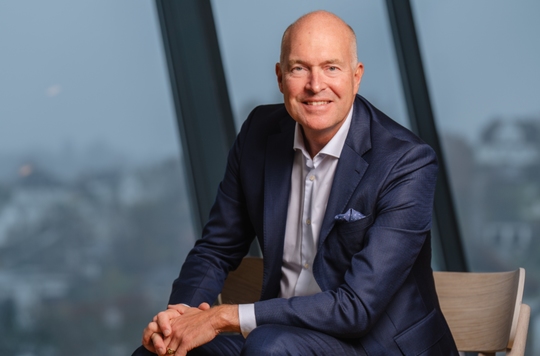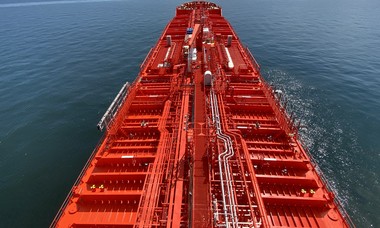This story is a translated version of an article first published by Økonomi24.
Written by Einar Ravndal, September 29, 2025.
Real actions, real transparency
Shipping is in the midst of a global climate challenge—with no simple answers. For Øistein Jensen, Odfjell SE’s sustainability efforts are about describing real actions, anchoring the direction with the Board, and communicating risks, investments, and choices with full transparency.
During EY’s Stock Exchange and IFRS Conference, Jensen shared insights on the connection between Odfjell’s actual sustainability actions and how they are reported.
- Reporting is the mirror, not the makeup. We show what we actually do, why we do it, and how it reduces risk—for our employees, operations, customers, and the company, he says.
From “hard-to-abate” to “the big opportunity”
- Nature cares about the total number of molecules in the atmosphere, not about intensity. But for management purposes, we need intensity targets—otherwise it is difficult to measure progress.
For Jensen, it is crucial to be open about both challenges and opportunities in the transition work:
- That’s how the organization, the Board, and the market can understand and be a part of the journey.
Shipping is often described as one of the hardest sectors to decarbonize. Jensen sees it differently—he believes Odfjell’s business model must also work in a low-emission future:

- We’re called a ‘hard-to-abate’ sector. I prefer to call it ‘the big opportunity’ sector. This is where major change can happen. There are no alternatives that can replace ships for transporting large volumes over long distances.
It’s the most environmentally friendly mode of transport. But shipping also accounts for 2–3% of the world’s CO₂ emissions. We are part of the problem—and our industry must help solve it.
Intensity over absolute emissions
Jensen is clear about the management logic:
- We want to grow as a company. That means that absolute emissions can increase, even if we become much more efficient. That’s why we manage based on intensity.
He admits that the concept can be challenging to explain:
- Nature cares about the total number of molecules in the atmosphere, not about intensity. But for management purposes, we need intensity targets—otherwise it is challenging to measure progress.
Global regulation is the key
For Jensen, the UN’s International Maritime Organization (IMO) is crucial to what shipping can achieve:
- IMO is the key. Global regulation based on consensus creates predictability. The strategy points toward net zero, and while it’s not a scientifically aligned 1.5°C pathway, it’s much better than having no common rules.
He notes that political tug-of-war affects the process—for instance, the U.S. has reportedly tried to slow progress by pressuring countries supporting the agreement.
- We remain positive that this will be adopted. It’s not a perfect solution, but it’s a good one—and it can push shipping toward net zero.
Reporting forces clarity—and becomes market information
- The new EU Reporting requirements forced us to be specific about how much we actually plan to invest, and that immediately becomes market information. - Øistein Jensen
One major step came when Odfjell had to quantify its investment plans in the sustainability report.
- We needed to provide more specific details about the future investments we would need. We calculated several scenarios—numbers we hadn’t previously communicated. The day after we published our transition plan in the report, industry media wrote that Odfjell plans to invest between USD 500 and 900 million, Jensen explains.
As a listed company, this balance between transparency and precise market communication is demanding.
In addition, Odfjell wanted to include clear principles in the transition plan:
We wanted to include elements like a "just and equitable transition" and a policy for offsetting. Offsets can be a supplement, but we must be clear about when and how we use them, says Jensen.
Reporting without dedicated systems
When Odfjell delivered its first ESRS report, everything was done manually without dedicated reporting tools.
- We did it 100% manually—with a small team. The advantage is speed and ownership. The downside is dependency on individuals and the need for stronger internal control.
The company reviewed around 20 system providers but found none that met their needs.
- Some were too expensive, others weakened internal control or didn’t support the way we communicate—with tables and graphics. So we’ll continue manually through 2025 and 2026.
To reduce risk, the company has tightened documentation, version control, and reference routines—and engages auditors early to ensure traceability.
When climate risk meets accounting
An important learning point came when the Financial Supervisory Authority of Norway examined climate risk and “stranded assets”—assets that lose value due to changing regulations, technology, or markets some years back.
- I thought, ‘of course we have that.’ But then it must also be reflected as an impairment in the accounts. That taught us that we must align financial and sustainability reporting.
Today, assessing climate risk and its financial implications is an integrated process at Odfjell.
Read the original article in Norwegian here.


